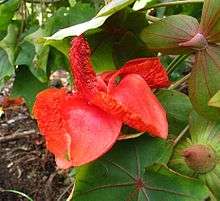Kokia drynarioides
Kokia drynarioides, commonly known as Hawaiian tree cotton, is a species of flowering plant in the mallow family, Malvaceae, that is endemic to the Big Island of Hawaii. It inhabits dry forests at elevations of 455–1,915 m (1,493–6,283 ft). Associated plants include ʻāheahea (Chenopodium oahuense), ʻaʻaliʻi (Dodonaea viscosa), hala pepe (Pleomele hawaiiensis), wiliwili (Erythrina sandwicensis), uhiuhi (Caesalpinia kavaiensis), kōlea (Myrsine lanaiensis), ʻaiea (Nothocestrum latifolium), kuluʻī (Nototrichium sandwicense), ʻālaʻa (Pouteria sandwicensis), ʻohe kukuluāeʻo (Reynoldsia sandwicensis), māmane (Sophora chrysophylla), and maua (Xylosma hawaiiense var. hillebrandii). It is threatened by habitat loss and competition with invasive species, such as Fountain Grass (Pennisetum setaceum).[3]
| Kokia drynarioides | |
|---|---|
 | |
| Scientific classification | |
| Kingdom: | Plantae |
| Clade: | Tracheophytes |
| Clade: | Angiosperms |
| Clade: | Eudicots |
| Clade: | Rosids |
| Order: | Malvales |
| Family: | Malvaceae |
| Genus: | Kokia |
| Species: | K. drynarioides |
| Binomial name | |
| Kokia drynarioides | |
| Synonyms[2] | |
| |
References
- "Kokia drynarioides". IUCN Red List of Threatened Species. 1998: e.T30933A9593828. 1998. doi:10.2305/IUCN.UK.1998.RLTS.T30933A9593828.en.
- "Kokia drynarioides". Germplasm Resources Information Network (GRIN). Agricultural Research Service (ARS), United States Department of Agriculture (USDA). Retrieved 2011-09-09.
- "Kokia drynarioides". CPC National Collection Plant Profiles. Center for Plant Conservation. 2010-09-28. Archived from the original on 2010-12-15. Retrieved 2011-04-21.
External links


- United States Botanic Garden: Kokia drynarioides
